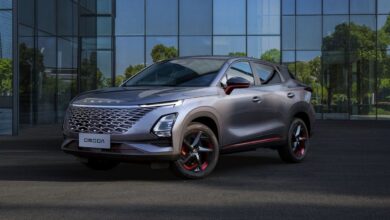Biden Administration Announces New Tailpipe Rules Aimed to Expand EVs

The Biden administration on Wednesday issued one of the most significant climate regulations in the nation’s history, a rule designed to ensure that the majority of new passenger cars and light trucks sold in the United States are all-electric or hybrids by 2032.
Nearly three years in the making, the new tailpipe pollution limits from the Environmental Protection Agency would transform the American automobile market. A record 1.2 million electric vehicles rolled off dealers’ lots last year, but they made up just 7.6 percent of total U.S. car sales, far from the 56 percent target under the new regulation. An additional 16 percent of new cars sold would be hybrids.
Cars and other forms of transportation are, together, the largest single source of carbon emissions generated by the United States, pollution that is driving climate change and that helped to make 2023 the hottest year in recorded history. Electric vehicles are central to President Biden’s strategy to confront global warming, which calls for cutting the nation’s emissions in half by the end of this decade. But E.V.s have also become politicized and are a flashpoint in the 2024 presidential campaign.
“Three years ago, I set an ambitious target: that half of all new cars and trucks sold in 2030 would be zero-emission,” said Mr. Biden in a statement. “Together, we’ve made historic progress. Hundreds of new expanded factories across the country. Hundreds of billions in private investment and thousands of good-paying union jobs. And we’ll meet my goal for 2030 and race forward in the years ahead.”
The rule increasingly limits the amount of pollution allowed from tailpipes over time so that, by 2032, more than half the new cars sold in the United States would most likely be zero-emissions vehicles in order for carmakers to meet the standards.
That would avoid more than seven billion tons of carbon dioxide emissions over the next 30 years, according to the E.P.A. That’s the equivalent of removing a year’s worth of all the greenhouse gases generated by the United States, the country that has historically pumped the most carbon dioxide into the atmosphere. The regulation would provide nearly $100 billion in annual net benefits to society, according to the agency, including $13 billion of annual public health benefits thanks to improved air quality.
The standards would also save the average American driver about $6,000 in reduced fuel and maintenance over the life of a vehicle, the E.P.A. estimated.
The transition to electric vehicles would require enormous changes in manufacturing, infrastructure, technology, labor, global trade and consumer habits.
And it has become politically fraught. Former President Donald J. Trump, who is campaigning to retake the White House from Mr. Biden in November, has sought to weaponize electric vehicles, repeating false claims during campaign rallies about their performance and affordability and using increasingly heated rhetoric. Most recently, he warned of a “blood bath” in the middle of a remarks about electric vehicles.
The American Fuel & Petrochemical Manufacturers, a lobbying organization, has started what it says is a “seven figure” campaign of advertising, phone calls and text messages against what it falsely calls “Biden’s E.P.A. car ban” in the swing states Pennsylvania, Michigan, Wisconsin, Nevada and Arizona, as well as in Ohio, Montana and the Washington, D.C., market.
The E.P.A. regulation is not a ban. It does not mandate the sales of electric vehicles, and gas-powered cars and trucks could still be sold. Rather, it requires carmakers to meet tough new average emissions limits across their entire product line. It’s up to the manufacturers to decide how to comply.
Under the Clean Air Act, the agency can limit the pollution generated by the total number of cars sold each year. E.P.A. officials said automakers could comply with the emissions caps by selling a mix of conventional gasoline-burning cars, hybrids, electric vehicles or other types of vehicles, such as cars powered by hydrogen. The new regulation, which would not apply to sales of used automobiles or light trucks, would take effect starting with model year 2027.
Car companies that exceed the new restrictions could face substantial penalties.
John Bozzella, president of the Alliance for Automotive Innovation, which represents 42 car companies that produce nearly all the new vehicles sold in the United States, said in a statement that the new rule was “a stretch goal” but one that offered some flexibility. “The future is electric,” he said. Still, the rules “are mindful of the importance of choice to drivers and preserve their ability to choose the vehicle that’s right for them,” he said.
But the rule is expected to face an immediate legal challenge by a coalition of fossil fuel companies and Republican attorneys general, complaints that are likely to wind their way to the Supreme Court.
“They may wish for us all to drive E.V.s or no cars at all, but at the end of the day that’s not their decision,” said Elizabeth Murrill, the attorney general of Louisiana, a major oil and gas producing state that has been involved in a series of lawsuits challenging the Biden E.P.A. “There is a limit to their authority to remake society in their own vision and the court has realized that.”
The auto emissions rule is the most impactful of four major climate regulations from the Biden administration, including restrictions on emissions from power plants, trucks and methane leaks from oil and gas wells. The rule comes on top of the 2022 Inflation Reduction Act, the biggest climate law in the nation’s history, which is providing at least $370 billion in federal incentives to support clean energy, including tax credits to buyers of electric vehicles.
The policies are intended to help the country meet Mr. Biden’s target of cutting U.S. greenhouse emissions in half by 2030 and eliminating them by 2050. Climate scientists say all major economies must do the same if the world is to avert the most deadly and costly effects of climate change.
“These standards form what we see as a historic climate grand slam for the Biden administration,” said Manish Bapna, president of the Natural Resources Defense Council Action Fund, a political action committee that aims to advance environmental causes.
Mr. Bapna’s group has calculated that the four regulations, combined with the Inflation Reduction Act, would reduce the nation’s greenhouse emissions 42 percent by 2030, getting the country most of the way to Mr. Biden’s 2030 target.
Mr. Trump has promised to delete those climate programs should he return to the White House.
The Biden administration is racing to finalize climate regulations to protect them from one looming threat in a polarized political climate: According to statute, as long as the rule is published more than 60 legislative days before the end of the presidential term, it cannot be eliminated by a simple majority vote in Congress.
In writing the final tailpipe regulation, the administration relaxed some elements in a concession to car manufacturers and their biggest union, the United Auto Workers.
Even though major auto companies have been investing substantially in building and marketing all-electric vehicles, they have complained that the pace of change required under the rule as originally proposed a year ago was too rapid.
Unionized auto workers, who fear a rapid transition to electric vehicles because they have fewer parts that require fewer workers to produce, and because many new E.V. plants are being built in states that don’t support union labor, told the White House the same thing.
In a statement on Wednesday, the United Auto Workers said the E.P.A. had “come a long way to create a more feasible emissions rule” that would protect workers who build gas-powered cars while creating a path for car makers to “implement the full range of automotive technologies to reduce emissions.”
Mr. Biden needs both cooperation from the auto industry and political support from the unionized auto workers who backed him in 2020. The auto industry employs thousands of voters in Michigan, a swing state that could determine who will win the White House in November.
In response, the final E.P.A. rule relaxed the pace at which automakers must comply with the rule in its early years, ramping it up sharply only after 2030.
That lowers the number of E.V.s that automakers must sell before 2030, and it also means that emissions will go down more slowly. Climate scientists have warned that emissions must drop sharply and quickly in order to stave off the most catastrophic impacts of climate change.
“E.P.A. caved to pressure from Big Auto, Big Oil and car dealers and riddled the plan with loopholes big enough to drive a Ford F150 through,” said Dan Becker, director of the Center for Biological Diversity’s Safe Climate Transport Campaign. Gas-powered cars would “dominate sales through much of this decade, guzzling and polluting into the middle of the century,” he said.
E.P.A. officials said the final rule would still cut the same amount of emissions over 30 years.
Asked about that trade-off in a telephone call with reporters, Michael S. Regan, the administrator of the E.P.A., said the changes were designed to lead to a “stronger, more durable” policy, in other words, one less likely to be rolled back by a future administration or the courts. “We’re not sacrificing the environmental gains we want to see,” he said.
Even if the new E.P.A. limits survive legal challenges, a transition away from the internal combustion engine depends on a number of other factors.
A lack of public charging stations for electric vehicles remains a problem. While more than 172,000 were installed last year, analysts project that the nation will need more than two million chargers by 2030 to support the growth in electric vehicles envisioned by the E.P.A. regulation.
At the same time, growth in sales of electric vehicles is slowing, even as the new regulations would require a nearly tenfold increase in such sales within just eight years. Buyers of new electric vehicles are eligible for up to $7,500 in federal tax credits, but only 18 models are currently eligible for that full credit, down from about two dozen last year. One of those eligible models, the Ford F-150 Lightning, an all-electric pickup truck that once had a waiting list of 200,000, last year saw sales of 24,000, far short of the 150,000 sales projected by Ford.
“At the end of the day, this is going to be up to consumers,” said Stephanie Brinley, an analyst for the Auto Intelligence service at S&P Global Mobility. “They’re being asked to change their patterns of what they drive, what they buy, how they interact with their vehicles. And you can’t push them faster than they are going to go.”



